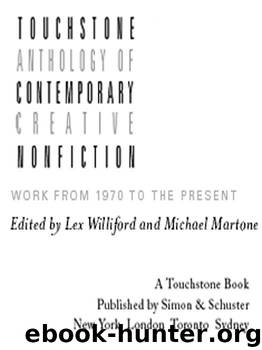Touchstone Anthology of Contemporary Creative Nonfiction by Williford Lex & Martone Michael

Author:Williford, Lex & Martone, Michael [Martone, Michael]
Language: eng
Format: epub, mobi
Publisher: Simon & Schuster, Inc.
Published: 2007-12-11T06:00:00+00:00
I went home for Thanksgiving and my father said, “Your shoes are cheap. Why don’t you buy another pair of shoes?”
Academics, in my experience, are not inclined to be generous to essayists. They are suspicious of humanism, nervous about too much style, and wary of public celebrations of the personal. They assume defensive postures and query: do essayists believe in uniqueness? Once, at a meeting to plan a graduate conference in literary studies, the kind of meeting where inclusivity is the aim, and the group spends three hours and forty minutes worrying about getting enough wheelchairs, ramps, crutches, hearing aids, tofu, baby-sitters, etc., to make “everyone feel welcome” but especially those people who never really are; once I suggested we open the calls to papers to include creative writing on the conference’s theme, and people looked at me as if I had requested a naked boy be hired to roller skate in and serve me cotton candy. Essayists are thought to be indulgent.
Which means lenient, messy, loose.
This essayist? Undisciplined? Able to set a perfect table but unable to arrange three consecutive thoughts? One might tackle these accusations in a methodical way, or only pretend to.
The essay seems disorganized, I think, because it has a stake in pretending not to know where it is going. Putting on its hat, heading for the door, it seems to follow the random movement of the mind itself. This looks like laziness, but it smells like epistemology. Because essays offer a way of thinking — a dramatization of process as opposed to a curtain unfurled on the final product, all scrubbed and clean as the newborn on TV. Unlike articles, they give form to the streakiest mental processes. I like to call the essayist a sketch artist for thought, since artistry is an important part of the package. Yes, yeah, right, my thoughts don’t really bump along this way, but they do bump somehow, and it’s more honest — more pedagogically useful, more truthful — to arrange them in a loose, disconnected, provisional way than to deliver only the conclusions.
Another thing that makes the essay seem like a mess is its refusal to decide the things it feels it cannot decide. The essay is willing to harbor contradictions. Like a hotel for disagreements, like a pillow on which discrepancy can rest her rumpled head. The article likes contradictions too but it starts with them and tries to resolve them; or it starts with something that doesn’t look like a contradiction at all, and methodically shows it to be one. Either way contradictions are cunningly displayed in such a way that the contradiction appears to be located outside — outside in a text, outside in the culture, most importantly, outside of the author.
Often an essay ends with out any contradiction solved. Often an essay doesn’t even push towards resolution. It thinks it is interesting with out a big bang.
Download
Touchstone Anthology of Contemporary Creative Nonfiction by Williford Lex & Martone Michael.mobi
This site does not store any files on its server. We only index and link to content provided by other sites. Please contact the content providers to delete copyright contents if any and email us, we'll remove relevant links or contents immediately.
The Rules Do Not Apply by Ariel Levy(4526)
Bluets by Maggie Nelson(4263)
Too Much and Not the Mood by Durga Chew-Bose(4096)
Pre-Suasion: A Revolutionary Way to Influence and Persuade by Robert Cialdini(3979)
The Motorcycle Diaries by Ernesto Che Guevara(3788)
Walking by Henry David Thoreau(3685)
What If This Were Enough? by Heather Havrilesky(3199)
Schaum's Quick Guide to Writing Great Short Stories by Margaret Lucke(3189)
The Daily Stoic by Holiday Ryan & Hanselman Stephen(3111)
The Day I Stopped Drinking Milk by Sudha Murty(3106)
Why I Write by George Orwell(2776)
The Social Psychology of Inequality by Unknown(2768)
Letters From a Stoic by Seneca(2673)
A Short History of Nearly Everything by Bryson Bill(2511)
Insomniac City by Bill Hayes(2399)
Feel Free by Zadie Smith(2379)
A Burst of Light by Audre Lorde(2349)
Upstream by Mary Oliver(2273)
Behave: The Biology of Humans at Our Best and Worst by Robert M. Sapolsky(2176)
